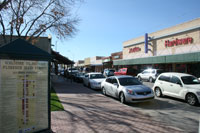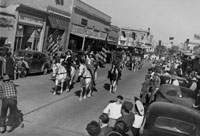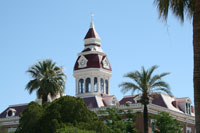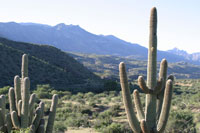|
|
Town Snapshot: Florence, AZ
Florence is located 60 miles southeast of Phoenix, Arizona and 70 miles northeast of Tucson, Arizona. Situated along the Gila River in the Sonoran Desert,
Florence is conveniently located to a variety of outdoor recreation activities. Cultural attractions are abundant and give the visitor a sense of the area's
history, from the earliest Native American residents through Florence's days as a rowdy western town. Florence's charming historic downtown boasts unique,
locally owned shops and restaurants that cater to residents and visitors alike.
 Florence was established in 1866 and is the sixth oldest European settlement in Arizona. Agriculture was the major economic activity until 1875 when Florence
became the government seat of Pinal County and silver was discovered at the Silver King Mine. Through the years, Florence played an important role as a regional
administrative center. An early and prominent figure in Florence's history was Charles D. Poston, known as the father of Arizona. Poston encouraged Congress to
create the Arizona Territory and was the territory's first elected delegate to Congress.
Florence was established in 1866 and is the sixth oldest European settlement in Arizona. Agriculture was the major economic activity until 1875 when Florence
became the government seat of Pinal County and silver was discovered at the Silver King Mine. Through the years, Florence played an important role as a regional
administrative center. An early and prominent figure in Florence's history was Charles D. Poston, known as the father of Arizona. Poston encouraged Congress to
create the Arizona Territory and was the territory's first elected delegate to Congress.
Another milestone in Florence's history was the canal boom in the 1880s which enabled water from the Gila River to be diverted for irrigation. Over time, farming
and ranching again played a major role in Florence's economy. The Florence Junior Parada began in 1932 when local ranchers held the rodeo to raise money for the
Children's Milk Fund. Today, the Florence Junior Parada is the oldest sanctioned youth rodeo in the world.
 The Arizona State Prison moved to Florence in 1908 replacing the Territorial Prison in Yuma. Inmates travelled from Yuma by train to build the prison and lived
in the surrounding desert during its construction. The oldest buildings at the prison complex are the Administration Building built in 1928 and Cellblock Two
(CB-2) which was completed in 1930. The gates leading into the Central Unit were brought to Florence from the Yuma Territorial Prison.
The Arizona State Prison moved to Florence in 1908 replacing the Territorial Prison in Yuma. Inmates travelled from Yuma by train to build the prison and lived
in the surrounding desert during its construction. The oldest buildings at the prison complex are the Administration Building built in 1928 and Cellblock Two
(CB-2) which was completed in 1930. The gates leading into the Central Unit were brought to Florence from the Yuma Territorial Prison.
Through its history, Florence's architecture evolved from rustic Sonoran adobe brick buildings to the Modern Movement. Florence is noted for its collection of
adobe buildings, the earliest dating back to 1868. All of the architectural styles that existed in Territorial Arizona can be found along the streets of Florence.
 There are many prominent recreational landmarks and areas of interest in and around Florence. The Gila River, Box Canyon, Martinez Canyon, and many other sites provide
fantastic scenic views and opportunities to hike, off-road and explore the surrounding Sonoran Desert. Other attractions in the Florence area include McFarland State
Historic Park, the Pinal County Historical Society Museum, Tom Mix Memorial, Florence Aero Modeler Park, the Charles Whitlow Rodeo Grounds, and Casa Grande Ruins National
Monument.
There are many prominent recreational landmarks and areas of interest in and around Florence. The Gila River, Box Canyon, Martinez Canyon, and many other sites provide
fantastic scenic views and opportunities to hike, off-road and explore the surrounding Sonoran Desert. Other attractions in the Florence area include McFarland State
Historic Park, the Pinal County Historical Society Museum, Tom Mix Memorial, Florence Aero Modeler Park, the Charles Whitlow Rodeo Grounds, and Casa Grande Ruins National
Monument.
 Florence is growing in population and in square miles. The town continues to annex properties and has steadily increased its residential population to approximately 10,000
people and its boundaries to approximately 65 square miles. In 2013, Florence issued 180 building permits for single family homes. There are approximately 7,000 jobs in
Florence with the largest employers being Pinal County, town of Florence, Florence Unified School District and ten correctional operations. Today, the town strives to strike
a balance between preserving the past and preparing for the future so that an authentic sense of place is maintained and new growth and revitalization is encouraged.
Florence is growing in population and in square miles. The town continues to annex properties and has steadily increased its residential population to approximately 10,000
people and its boundaries to approximately 65 square miles. In 2013, Florence issued 180 building permits for single family homes. There are approximately 7,000 jobs in
Florence with the largest employers being Pinal County, town of Florence, Florence Unified School District and ten correctional operations. Today, the town strives to strike
a balance between preserving the past and preparing for the future so that an authentic sense of place is maintained and new growth and revitalization is encouraged.
|
|
League of Arizona Cities and Towns
1820 W. Washington St.
Phoenix, AZ 85007
Phone: 602-258-5786
Fax: 602-253-3874
http://www.azleague.org
|
|
|

